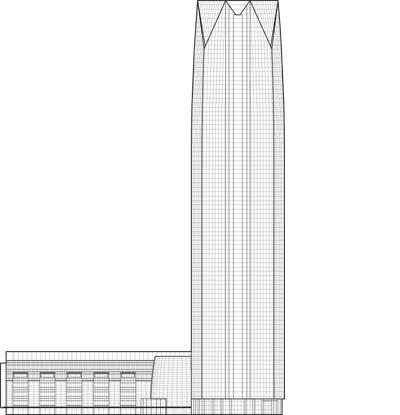Filter by
You must be a CTBUH Member to view this resource.

Devon Energy Center
Devon Energy Tower, Devon Tower, Devon Headquarters
Building
Completed
2012
Office
All-Concrete
LEED Gold
257.2 m / 844 ft
52
2
2793
52
6.1 m/s
125,812 m² / 1,354,229 ft²
You must be a CTBUH Member to view this resource.
You must be a CTBUH Member to view this resource.
Proposed
Construction Start
Completed
Usually involved in the front end design, with a "typical" condition being that of a leadership role through either Schematic Design or Design Development, and then a monitoring role through the CD and CA phases.
The Design Engineer is usually involved in the front end design, typically taking the leadership role in the Schematic Design and Design Development, and then a monitoring role through the CD and CA phases.
The Design Engineer is usually involved in the front end design, typically taking the leadership role in the Schematic Design and Design Development, and then a monitoring role through the CD and CA phases.
Other Consultant refers to other organizations which provided significant consultation services for a building project (e.g. wind consultants, environmental consultants, fire and life safety consultants, etc).
These are firms that consult on the design of a building's façade. May often be referred to as "Cladding," "Envelope," "Exterior Wall," or "Curtain Wall" Consultant, however, for consistency CTBUH uses the term "Façade Consultant" exclusively.
Material Supplier refers to organizations which supplied significant systems/materials for a building project (e.g. elevator suppliers, facade suppliers, etc).
You must be a CTBUH Member to view this resource.
Usually involved in the front end design, with a "typical" condition being that of a leadership role through either Schematic Design or Design Development, and then a monitoring role through the CD and CA phases.
Usually takes on the balance of the architectural effort not executed by the "Design Architect," typically responsible for the construction documents, conforming to local codes, etc. May often be referred to as "Executive," "Associate," or "Local" Architect, however, for consistency CTBUH uses the term "Architect of Record" exclusively.
The Design Engineer is usually involved in the front end design, typically taking the leadership role in the Schematic Design and Design Development, and then a monitoring role through the CD and CA phases.
The Design Engineer is usually involved in the front end design, typically taking the leadership role in the Schematic Design and Design Development, and then a monitoring role through the CD and CA phases.
The main contractor is the supervisory contractor of all construction work on a project, management of sub-contractors and vendors, etc. May be referred to as "Construction Manager," however, for consistency CTBUH uses the term "Main Contractor" exclusively.
Other Consultant refers to other organizations which provided significant consultation services for a building project (e.g. wind consultants, environmental consultants, fire and life safety consultants, etc).
These are firms that consult on the design of a building's façade. May often be referred to as "Cladding," "Envelope," "Exterior Wall," or "Curtain Wall" Consultant, however, for consistency CTBUH uses the term "Façade Consultant" exclusively.
Material Supplier refers to organizations which supplied significant systems/materials for a building project (e.g. elevator suppliers, facade suppliers, etc).
2013 CTBUH Awards
2022 CTBUH Awards

18 October 2016 | Oklahoma City
Tuesday, October 18, 2016. Shenzhen, China. Ron Klemencic, Magnusson Klemencic Associates; Karl Almstead, Turner Construction Company; Andrew Nicholson, CBRE; Jon Pickard, Pickard Chilton; Ian Smith,...

16 May 2019
Two window washers were working atop a 52-story skyscraper in Oklahoma City on Wednesday morning, 15 May, 2019, when strong gusts of wind began swinging...
Devon Energy Center creates a focal point for the company and Oklahoma City by integrating civic-scaled spaces as a vital component of its overall development. It consolidates Devon’s Oklahoma City–based workforce into a single state-of-the-art facility with numerous amenities.
The three-sided tower evolved in part from Devon’s desire to not “turn its back” on any part of the city. Its orientation and placement provide southern exposure to the park while minimizing solar gain. Its form resulted in highly efficient tripartite floor plates averaging 28,000 square feet that accommodate up to 12 full-corner offices. Responsive to the theme of a “right to light” for all occupants, the 10-foot floor-to-ceiling glazing allows daylight deep into the Tower as well as expansive views. All perimeter offices have floor-to-ceiling glass to maximize daylight. The curtain wall consists of continuous high-performance clear glass with a low-E coating that maximizes daylight, while also reducing heat gain.
With a highly articulated structure, the Rotunda is a grand civic-scaled space with glass walls, a series of balconies, and sky-lit roof. It regularly serves as a venue for special events. Unifying the entire complex within the city, the jewel-like Rotunda symbolically and literally connects the cardinal directions, punctuating the urban axis of Harvey Street. The Rotunda provides 12,522 square feet (1,163 square meters) of welcome assembly space and has hosted fund-raisers, holiday balls, corporate dinners, and civic gatherings.
The Podium contains training and meeting spaces as well as visitor and occupant services. A promenade extending its length creates a glazed day-lit interior corridor. At street level, it provides public access to various amenities, including restaurants, and includes a series of indoor seating areas for dining and overlooking the park.
Defining an urban edge, the Auditorium is a prominent, but intimately scaled, multi-use venue for both corporate and public events. Although nestled into the landscaped park, its strong presence activates street life and supports the downtown’s vitality, while providing dramatic views of downtown and Myriad Botanical Gardens.
The building is among the largest LEED-NC Gold-certified buildings worldwide. The chosen site has direct access to public transit. Construction of the building minimally impacted the natural environment by diverting 68,000 tons (61,669 metric tons) of waste and concrete from landfills and recycling 100 percent of a demolished parking deck on the site. The building also performs well operationally. Potable water consumption is reduced by 50 percent through landscape design and irrigation; overall water use is reduced by 40 percent. Energy use is modulated by district cooling with on-site co-generation, personal comfort control for 50 percent of occupants and personal lighting control for 90 percent of occupants.
2013 CTBUH Awards
2022 CTBUH Awards

18 October 2016 | Oklahoma City
Tuesday, October 18, 2016. Shenzhen, China. Ron Klemencic, Magnusson Klemencic Associates; Karl Almstead, Turner Construction Company; Andrew Nicholson, CBRE; Jon Pickard, Pickard Chilton; Ian Smith,...

18 October 2016 | Oklahoma City
Jon Pickard of Pickard Chilton is interviewed by Chris Bentley during the 2016 CTBUH China Conference. Jon discusses the local economic impacts of tall buildings.
Subscribe below to receive periodic updates from CTBUH on the latest Tall Building and Urban news and CTBUH initiatives, including our monthly newsletter. Fields with a red asterisk (*) next to them are required.
View our privacy policy